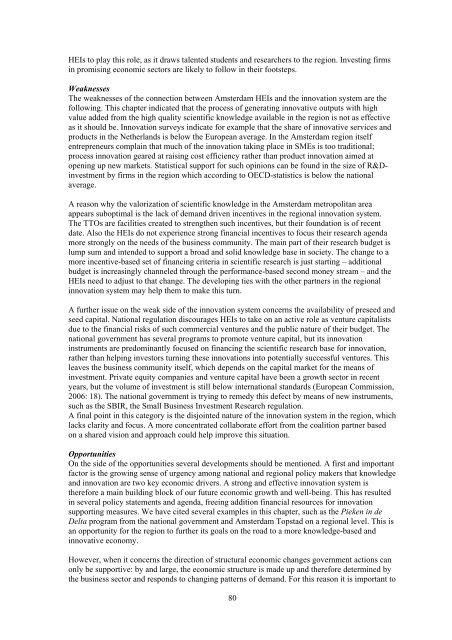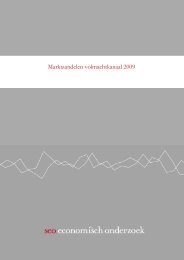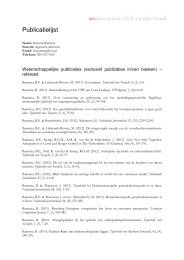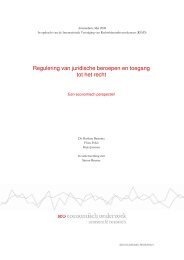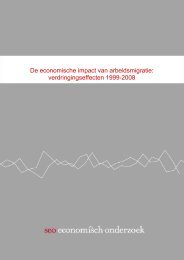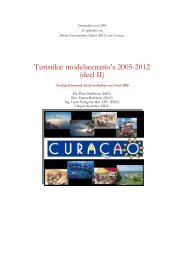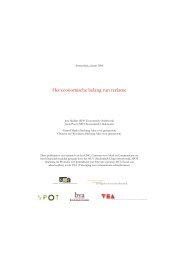Amsterdam, Netherlands - SEO Economisch Onderzoek
Amsterdam, Netherlands - SEO Economisch Onderzoek
Amsterdam, Netherlands - SEO Economisch Onderzoek
Create successful ePaper yourself
Turn your PDF publications into a flip-book with our unique Google optimized e-Paper software.
HEIs to play this role, as it draws talented students and researchers to the region. Investing firmsin promising economic sectors are likely to follow in their footsteps.WeaknessesThe weaknesses of the connection between <strong>Amsterdam</strong> HEIs and the innovation system are thefollowing. This chapter indicated that the process of generating innovative outputs with highvalue added from the high quality scientific knowledge available in the region is not as effectiveas it should be. Innovation surveys indicate for example that the share of innovative services andproducts in the <strong>Netherlands</strong> is below the European average. In the <strong>Amsterdam</strong> region itselfentrepreneurs complain that much of the innovation taking place in SMEs is too traditional;process innovation geared at raising cost efficiency rather than product innovation aimed atopening up new markets. Statistical support for such opinions can be found in the size of R&Dinvestmentby firms in the region which according to OECD-statistics is below the nationalaverage.A reason why the valorization of scientific knowledge in the <strong>Amsterdam</strong> metropolitan areaappears suboptimal is the lack of demand driven incentives in the regional innovation system.The TTOs are facilities created to strengthen such incentives, but their foundation is of recentdate. Also the HEIs do not experience strong financial incentives to focus their research agendamore strongly on the needs of the business community. The main part of their research budget islump sum and intended to support a broad and solid knowledge base in society. The change to amore incentive-based set of financing criteria in scientific research is just starting – additionalbudget is increasingly channeled through the performance-based second money stream – and theHEIs need to adjust to that change. The developing ties with the other partners in the regionalinnovation system may help them to make this turn.A further issue on the weak side of the innovation system concerns the availability of preseed andseed capital. National regulation discourages HEIs to take on an active role as venture capitalistsdue to the financial risks of such commercial ventures and the public nature of their budget. Thenational government has several programs to promote venture capital, but its innovationinstruments are predominantly focused on financing the scientific research base for innovation,rather than helping investors turning these innovations into potentially successful ventures. Thisleaves the business community itself, which depends on the capital market for the means ofinvestment. Private equity companies and venture capital have been a growth sector in recentyears, but the volume of investment is still below international standards (European Commission,2006: 18). The national government is trying to remedy this defect by means of new instruments,such as the SBIR, the Small Business Investment Research regulation.A final point in this category is the disjointed nature of the innovation system in the region, whichlacks clarity and focus. A more concentrated collaborate effort from the coalition partner basedon a shared vision and approach could help improve this situation.OpportunitiesOn the side of the opportunities several developments should be mentioned. A first and importantfactor is the growing sense of urgency among national and regional policy makers that knowledgeand innovation are two key economic drivers. A strong and effective innovation system istherefore a main building block of our future economic growth and well-being. This has resultedin several policy statements and agenda, freeing addition financial resources for innovationsupporting measures. We have cited several examples in this chapter, such as the Pieken in deDelta program from the national government and <strong>Amsterdam</strong> Topstad on a regional level. This isan opportunity for the region to further its goals on the road to a more knowledge-based andinnovative economy.However, when it concerns the direction of structural economic changes government actions canonly be supportive: by and large, the economic structure is made up and therefore determined bythe business sector and responds to changing patterns of demand. For this reason it is important to80


